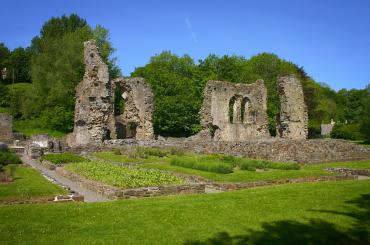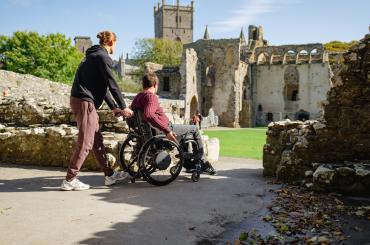Llawhaden Castle
Forgotten castle-cum-mansion that stays in the memory
It’s worth taking the short detour off the busy A40 as you drive through Pembrokeshire to visit this little-known castle. Occupying a commanding location amongst serene forest and rolling farmland, Llawhaden’s unconventional mix of military and decorative features reveal its main purpose in life: that of a fortified mansion more than out-and-out castle, designed as a residence for the wealthy bishops of St Davids who liked their home comforts.
The site had seen much active service before being reconstructed along its present lines in the 14th century by Bishop David Martin. There were private apartments, a courtyard, lodgings for guests and quarters for a permanent garrison. Most impressive of all is the front of the gatehouse, added in the later 14th century, still standing to its full height.
Opening times & prices
Opening times
| 1st April - 31st March | 10am–4pm |
|---|---|
|
Last admission 30 minutes before closing Closed 24, 25, 26 December and 1 January |
|
Visitor information
Car park
Limited parking within 250 metres of the castle (5 spaces).
Access is via a tarmaced lane.
Dogs welcome
Dogs on short leads welcome to access ground floor levels of the site.
Walking difficulty
Terrain: Level 2 – Easy
Drone policy
Please read our policy information about flying drones at Cadw monuments: read the guidance
No smoking
Smoking is not permitted.
Health & Safety
Access into the castle involves a short incline walk along an uneven path. This is sometimes slippery when wet and contains historic bed rock, which may cause a trip hazard.
Lower parts of the outer grounds can become flooded and with deep water pooling in parts. Attention must be paid when visiting in poor weather conditions.
Most of the site is grassed and the internal areas are predominantly flat.
There is a mix of historic stone and modern steel step infrastructure; these can be slippery when wet, please use handrails where provided.
Guardrails have been installed to prevent access to any areas of the site that we have deemed as dangerous or to prevent falls in specific areas.
Please do not climb over or through any fixed installation.
As with all ancient monuments there is always a risk of stones being dislodged in bad weather, however, we manage this through extensive monitoring.
Climbing may result in serious injury.
There are several wild plants and flowers, although these are great pollinators, they may be poisonous to visitors and animals, we strongly advise you not to touch or allow dogs to eat any vegetation.
Please watch our health & safety film before visiting Cadw sites.
Iechyd a Diogelwch / Health and Safety
Please report any anti-social behaviour such as climbing, setting fires, graffiti etc. to CadwAccidentsReports@gov.wales
The following signs can be found around the site at key areas of risk, please pay attention where appropriate.
Falls from height
Deep water
Falling masonry
Slippery or uneven surfaces
Steep and uneven steps
Directions
Google MapGrid Ref: SN072174. Lat/Lon: 51.8223, -4.7976
what3words: ///fell.pram.perused
Related
Unlimited access to Wales' past
Join Cadw for as little as £2.00 a month and gain unlimited access to over 100 historical sites.
Enjoy the many benefits of Cadw membership
- 10% off Cadw gift shops
- 50% off entry to English Heritage and Historic Scotland sites
- FREE entry to English Heritage and Historic Scotland on renewal
- FREE entry to Manx National Heritage properties
- FREE membership pack including car sticker and full colour map

